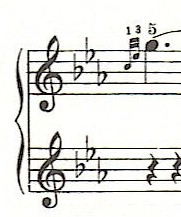Cadential Structure in Beethoven's Op. 10 No. 1 (First Movement) |
[I-IV-V-I] Prolongation of Function Elaboration of Motion In Symphonic: Back / Next |
Introduction The Chaconne Cadential Structure --- Unitary & Binary Structures Linear & Periodic Structures Riff Modalities Structural Counterpoint Modular Composition Appendices |
| RIFFS Cadential Structure In Symphonic Composition: Analysis of Beethoven's Op. 10 No. 1 (First Movement) Lester Allyson Knibbs, Ph.D. |
| The first movement of Beethoven's piano sonata in c-minor, opus 10 no. 1, is an example of tight construction, similar to opus 2 No. 1, with the initial structural tonic prolonged into the latter part of the development section. |
| This movement opens with a far more elaborate statement than the opening of op. 2 no. 1. (Examples again are from Ludwig van Beethoven Complete Piano Sonatas, v. 1, Heinrich Schenker, ed., Dover Publications, Inc., New York, 1975; and again, measure numbers appear at the end of every fifth measure - i.e., measure 5 has a large "5" in a circle over the bar line at the end of the fifth measure.) |
| The first eight measures (example 241b.1) bear a superficial resemblance to an eight-bar period. Rhythmically, melodically and harmonically they are incomplete, however, and are the beginning of a 22-measure sentence (mm. 1-22). |
| Example 241b.1 |
 |
| Rhythmically, these opening eight measures appear to consist of two parallel four-measure statements. Each four-measure statement consists of two ideas - an explosive idea that rockets upward in a sharp dotted rhythm, and a sedate idea whose melody settles slightly downward in a much more relaxed rhythm. |
| These eight measures are not only incomplete, but intensely unbalanced. A balanced statement would consist of four two-measure units. These eight measures consist of a three-measure phrase and a two-measure phrase answered by another three-measure phrase and another two-measure phrase. This would be ten measures, except for the overlap in measure five. (Harmonically and melodically, it's an overlap, but dynamically, it's an interruption. See measures 113-114 for a complete statement of this two-measure motivic idea.) That makes it nine measures, and, in actual fact, this opening idea is both completed and continued in the rising triad at the beginning of measure nine (example 241b.2). |
 |
| Example 241b.2 |
| Melodically, this rising triad completes the motion from the opening c-natural to the high e-flat, continuing to the high f-natural, and concluding on the g-natural in measure nine. The rising triad recapitulates the "rocket" idea in miniature form. The c-natural in measure nine completes the second statement of the secondary motivic idea: c-c-b-b in measures 3-5 and d-d-c-c in measures 7-9. |
| Harmonically, the rising triad completes the statement of an idea punctuated by the full forte chords in measures one and five and the repeated high notes in measures 2-3 and 6-7: c-natural and e-flat (tonic harmony, measures 1-3), moving to b-natural and f-natural (dominant harmony, measures 5-7), resolving to c-natural and e-flat (or c-natural and g-natural, tonic harmony, measure nine). |
| Sonata Movements Op. 2 No. 1 (I) Op. 10 No. 1 (I) 1 2 3 4 |